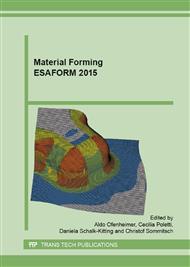p.65
p.71
p.77
p.83
p.89
p.96
p.102
p.108
p.114
Diffusion Effects Induced by Dislocations in Crystalline Materials Subjected to Large Strains
Abstract:
We reconsider here the FEM-algorithm for solving the initial and boundary value problems performed within the viscoplastic constitutive framework and proposed in our paper [1]. The problems concerning the deformation of a sheet composed of a single fcc-crystal, generated by different slip systems simultaneously activated, are solved numerically for an in-plane stress state. The variational formulation is associated to the incremental equilibrium equations and is coupled with an update procedure for the state variables, which are described by the differential type equations, as well as for the non-local evolution equations of the dislocation densities. The length scale parameter is introduced into the model through the diffusion-like parameter which enters the evolution equations for dislocation densities. For more accuracy of the simulation, the shape functions have been chosen polynomials with higher than one degree. We do not consider that once a slip system was activated it remains active for the rest of simulation. The activation condition is a key point in the numerical algorithm. As a numerical example, we perform a tensile test of a rectangular and non-rectangular metallic sheet, comparring the results of the simulation when two, respectively eight slip systems are considered.
Info:
Periodical:
Pages:
89-95
Citation:
Online since:
July 2015
Authors:
Price:
Сopyright:
© 2015 Trans Tech Publications Ltd. All Rights Reserved
Share:
Citation:


